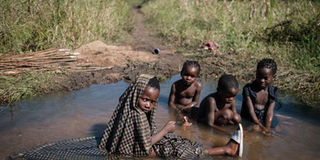Mozambique cyclone survivors face 'ticking bomb' of disease

Children play in a new stream created by flooded water after the passage of the cyclone Idai in Tica, Mozambique, on March 24, 2019. PHOTO | YASUYOSHI CHIBA | AFP
What you need to know:
Cyclone Idai smashed into Mozambique's coast, unleashing hurricane-force wind and rain that flooded swathes of the poor country.
Medical services in the affected region were stretched even before the cyclone hit and according to aid group MSF.
- The UN has warned that stagnant water, decomposing bodies and the lack of sanitation in overcrowded shelters in Mozambique could create breeding grounds for diseases.
Beira,
Survivors of a powerful cyclone that pummelled southern Africa were to begin receiving emergency medicine, food and tents on Tuesday as floodwaters receded, while the Red Cross warned of "a ticking bomb" of disease in the storm-struck region.
Cyclone Idai smashed into Mozambique's coast, unleashing hurricane-force wind and rain that flooded swathes of the poor country before battering eastern Zimbabwe -- killing more than 700 people across the two nations.

Rosita Moises Zacarias (left), 15 and her sister Joaninha Manuel, 9, walk in flooded waters from their house destroyed by the cyclone Idai, in Buzi, Mozambique, on March 22, 2019. PHOTO | YASUYOSHI CHIBA | AFP
The head of the International Federation of Red Cross and Red Crescent Societies (IFRC) Elhadj As Sy said Monday "we are sitting on a ticking bomb" as he called for renewed efforts to address the worsening health situation.
As logistical conditions improved and roads to affected communities have been reconnected, the full scale of the humanitarian crisis has been revealed for the first time since disaster hit on March 15.
More than two million people have been affected in Mozambique, Zimbabwe and Malawi where the storm started as a tropical depression causing deadly flooding which displaced nearly a million people.

Carlo Antonio, 58, sleeps on a tree damaged by the cyclone Idai at an evacuation site in Tica, Mozambique, on March 24, 2019. PHOTO | YASUYOSHI CHIBA | AFP
Hundreds are still missing in Mozambique and Zimbabwe.
RESCUE
"The conditions for rescue are improving. Yesterday a road reopened which was really important to allow officials to work and rescue," Mozambique's Land Minister Celso Correa told reporters on Monday.
The UN Office for the Coordination of Humanitarian Affairs' Sebastian Rhodes Stampa also said Monday that 30 aid missions were flying in while others were going by road "so we can really deliver volume".
"We are packing food and shelter now -- they will go out (Tuesday) both north and south," he said.

A girl sits on a kiosk destroyed by the cyclone Idai in Tica, Mozambique, on March 24, 2019. PHOTO | YASUYOSHI CHIBA | AFP
In New York, UN aid chief Mark Lowcock launched an appeal to provide Mozambique with $282 million to help with relief efforts over the next three months.
Lowcock told reporters that similar campaigns would be instigated in the coming days for Zimbabwe and Malawi.
Buzi, one of Mozambique's worst-hit towns located 30 kilometres (19 miles) southwest of the city of Beira, became reachable by road on Monday -- for the first time since the storm hit.
"It will now be much faster to deliver aid," Stampa added.
40 COWS
In Buzi, survivor Joao Zacaria said that "one man who had 40 cows lost them all. Forty, can you imagine!"

People try to recover house materials from water after a house was destroyed by the Cyclone Idai in John Segredo, Mozambique, on March 24, 2019. PHOTO | YASUYOSHI CHIBA | AFP
IFRC head Sy, who had just returned from the region, warned of a "high risk of water-borne diseases" like cholera and typhus -- as well as malaria, which is endemic in the region.
A procession of mourners carried the coffin containing the body of Tomas Joaquim Chimukme, who was killed by the cyclone, through saturated marshland outside Beira.
Many of those attending wore open sandals in the water which was ankle-high.
The UN has warned that stagnant water in many areas, decomposing bodies and the lack of sanitation in overcrowded shelters in Mozambique could create breeding grounds for such diseases.

People queue to buy breads in Beira, Mozambique, on March 24, 2019. Cyclone Idai smashed into Mozambique's coast unleashing hurricane-force wind and rain that flooded swathes of the poor country before battering eastern Zimbabwe -- killing 705 people across the two nations. PHOTO | YASUYOSHI CHIBA | AFP
The government has already identified some suspected but unconfirmed cases of cholera, Sy said.
DISEASES
"That is the reason why I am raising the alarm. Many of these water-borne diseases are a great risk, but they are preventable," he added.
"The worst thing is the children crying and looking for their parents... It is heartbreaking," he said, adding that it remained unclear how many children may have been orphaned.

People walk on the N6 road re-constructed in three days by China State Construction after the original road was destroyed by the cyclone Idai in John Segredo, on March 24, 2019. PHOTO | YASUYOSHI CHIBA | AFP
Medical services in the affected region were stretched even before the cyclone hit and according to aid group MSF, Beira hospital's operating theatre sustained serious damage. As many as 17 health centres have lost their roofs, it added in a statement.
The South African military has deployed several aircraft to the affected area and an EU-funded World Food Programme chopper is supporting rescue and recovery efforts.





